Advanced Digital Computing: IP Addressing and Networking Report
VerifiedAdded on 2022/10/06
|30
|2934
|398
Report
AI Summary
This report comprehensively analyzes IP addressing and subnet calculations within the context of a network designed for Advanced Digital Computing. It begins by detailing the seven layers of the OSI reference model, distinguishing between hardware and software layers, and comparing the OSI model's network layer with the TCP/IP model's Internet layer. The report then documents hands-on projects, including configurations and findings related to IP addressing and subnetting. Furthermore, it presents a WAN network design, explaining the network layout and IP addressing schemes for individual devices. An IP address table with subnet details is provided, along with an explanation of the CIDR addressing scheme used. The report concludes by summarizing the key aspects of IP addressing and subnet calculations. This report provides valuable insights into the practical application of networking principles.

Running head: IP ADDRESSING AND NETWORKING
IP Addressing and Networking
Name of the Student
Name of the University
Author Note
IP Addressing and Networking
Name of the Student
Name of the University
Author Note
Paraphrase This Document
Need a fresh take? Get an instant paraphrase of this document with our AI Paraphraser
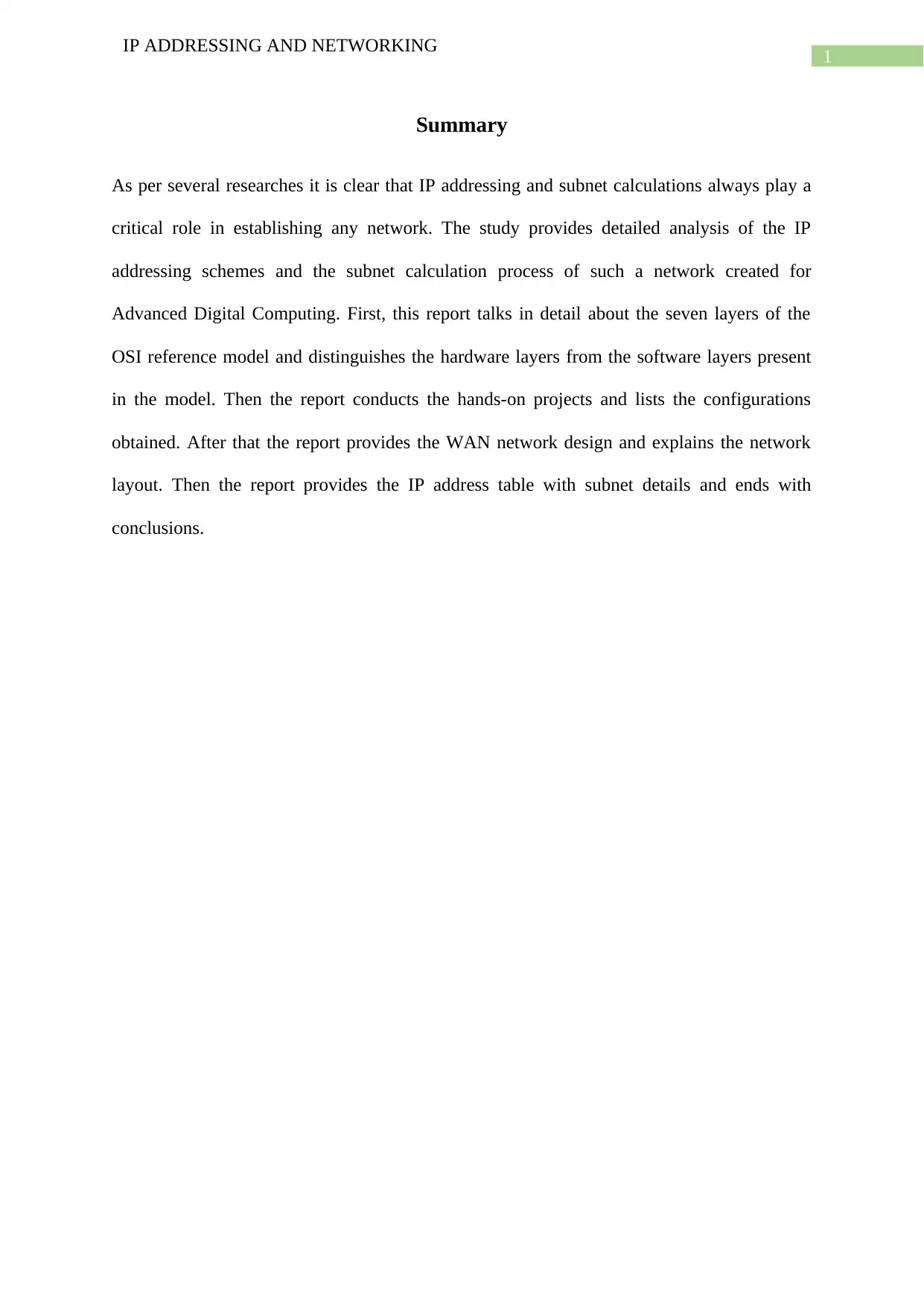
1
IP ADDRESSING AND NETWORKING
Summary
As per several researches it is clear that IP addressing and subnet calculations always play a
critical role in establishing any network. The study provides detailed analysis of the IP
addressing schemes and the subnet calculation process of such a network created for
Advanced Digital Computing. First, this report talks in detail about the seven layers of the
OSI reference model and distinguishes the hardware layers from the software layers present
in the model. Then the report conducts the hands-on projects and lists the configurations
obtained. After that the report provides the WAN network design and explains the network
layout. Then the report provides the IP address table with subnet details and ends with
conclusions.
IP ADDRESSING AND NETWORKING
Summary
As per several researches it is clear that IP addressing and subnet calculations always play a
critical role in establishing any network. The study provides detailed analysis of the IP
addressing schemes and the subnet calculation process of such a network created for
Advanced Digital Computing. First, this report talks in detail about the seven layers of the
OSI reference model and distinguishes the hardware layers from the software layers present
in the model. Then the report conducts the hands-on projects and lists the configurations
obtained. After that the report provides the WAN network design and explains the network
layout. Then the report provides the IP address table with subnet details and ends with
conclusions.
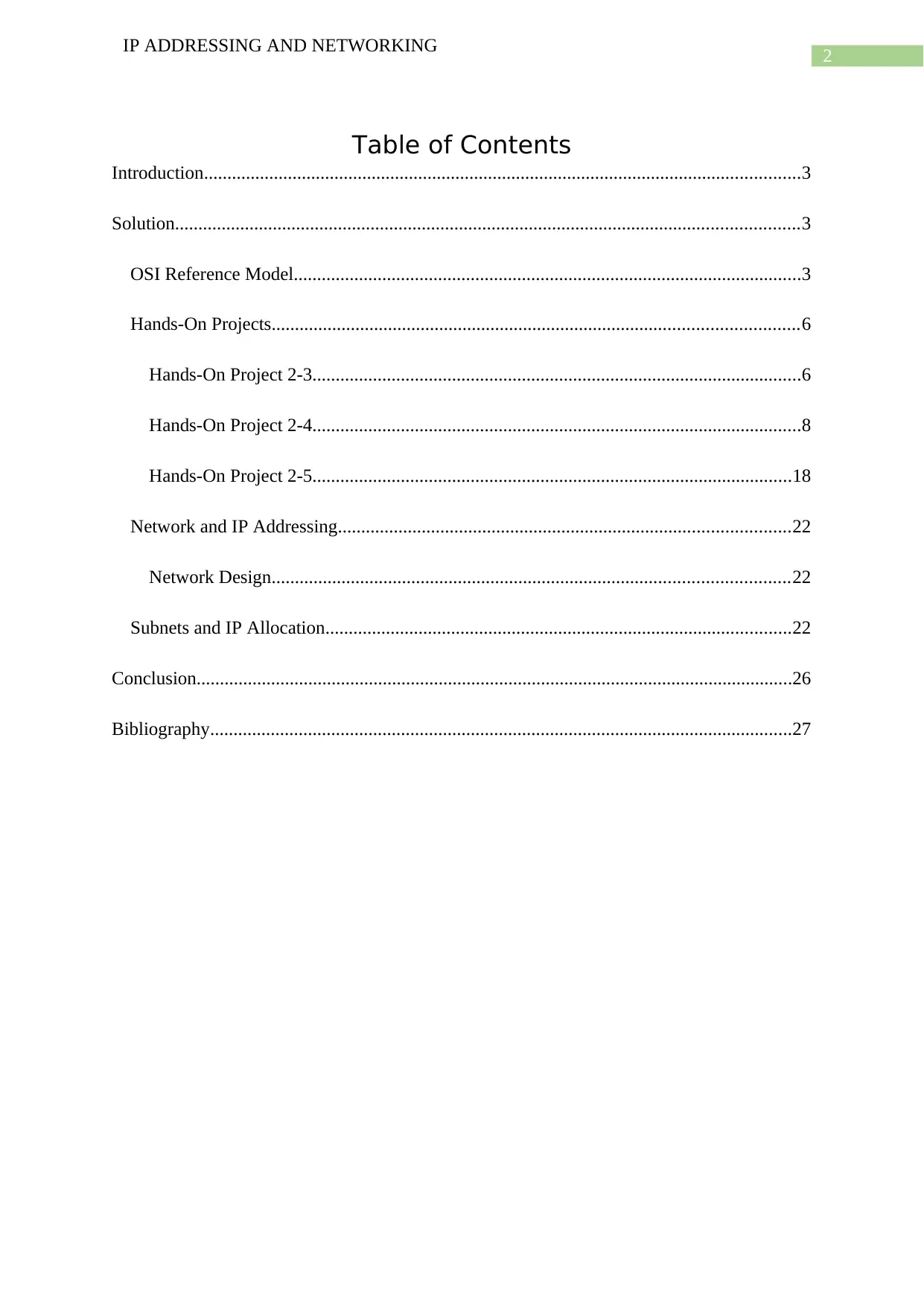
2
IP ADDRESSING AND NETWORKING
Table of Contents
Introduction................................................................................................................................3
Solution......................................................................................................................................3
OSI Reference Model.............................................................................................................3
Hands-On Projects.................................................................................................................6
Hands-On Project 2-3.........................................................................................................6
Hands-On Project 2-4.........................................................................................................8
Hands-On Project 2-5.......................................................................................................18
Network and IP Addressing.................................................................................................22
Network Design...............................................................................................................22
Subnets and IP Allocation....................................................................................................22
Conclusion................................................................................................................................26
Bibliography.............................................................................................................................27
IP ADDRESSING AND NETWORKING
Table of Contents
Introduction................................................................................................................................3
Solution......................................................................................................................................3
OSI Reference Model.............................................................................................................3
Hands-On Projects.................................................................................................................6
Hands-On Project 2-3.........................................................................................................6
Hands-On Project 2-4.........................................................................................................8
Hands-On Project 2-5.......................................................................................................18
Network and IP Addressing.................................................................................................22
Network Design...............................................................................................................22
Subnets and IP Allocation....................................................................................................22
Conclusion................................................................................................................................26
Bibliography.............................................................................................................................27
⊘ This is a preview!⊘
Do you want full access?
Subscribe today to unlock all pages.

Trusted by 1+ million students worldwide
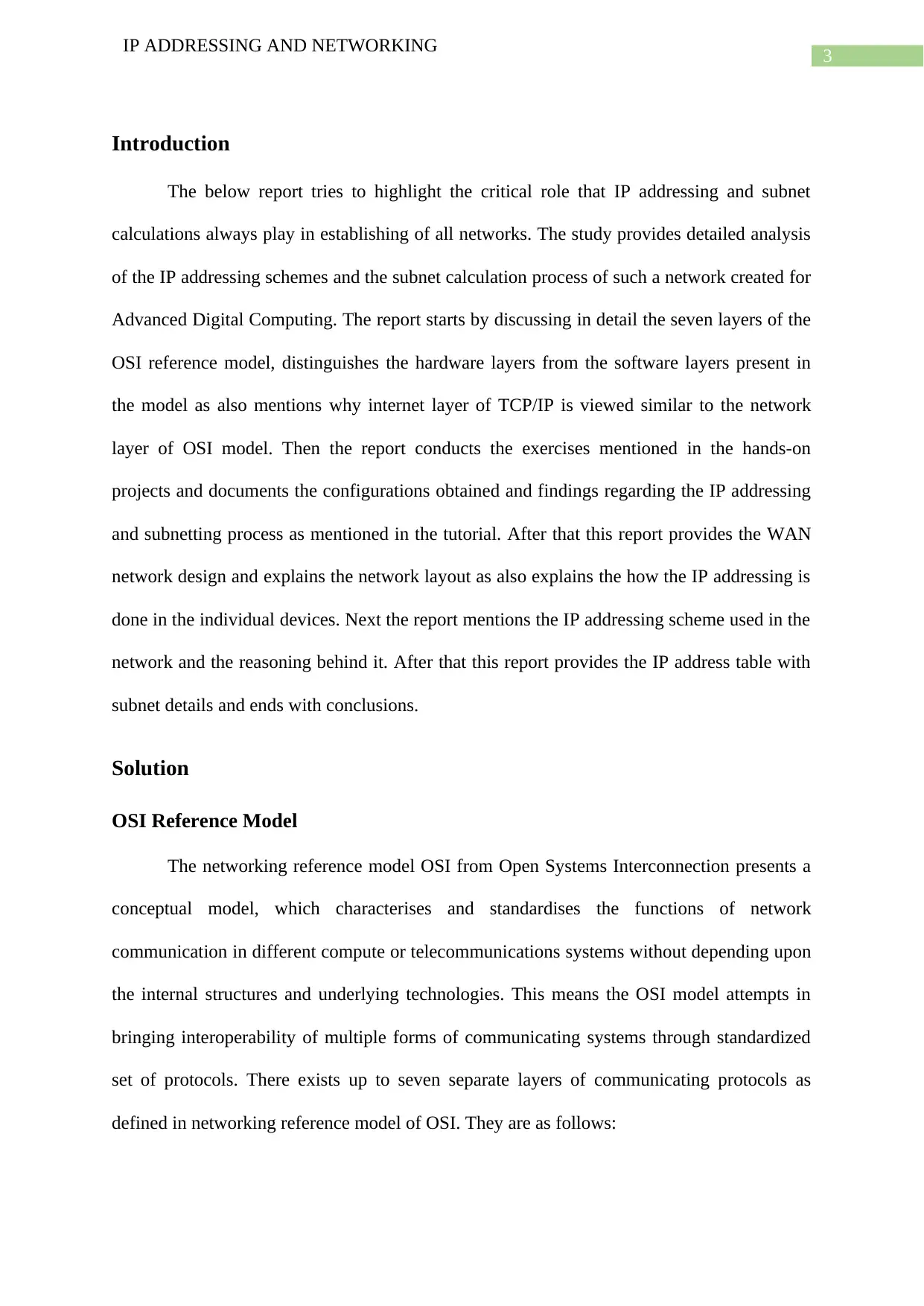
3
IP ADDRESSING AND NETWORKING
Introduction
The below report tries to highlight the critical role that IP addressing and subnet
calculations always play in establishing of all networks. The study provides detailed analysis
of the IP addressing schemes and the subnet calculation process of such a network created for
Advanced Digital Computing. The report starts by discussing in detail the seven layers of the
OSI reference model, distinguishes the hardware layers from the software layers present in
the model as also mentions why internet layer of TCP/IP is viewed similar to the network
layer of OSI model. Then the report conducts the exercises mentioned in the hands-on
projects and documents the configurations obtained and findings regarding the IP addressing
and subnetting process as mentioned in the tutorial. After that this report provides the WAN
network design and explains the network layout as also explains the how the IP addressing is
done in the individual devices. Next the report mentions the IP addressing scheme used in the
network and the reasoning behind it. After that this report provides the IP address table with
subnet details and ends with conclusions.
Solution
OSI Reference Model
The networking reference model OSI from Open Systems Interconnection presents a
conceptual model, which characterises and standardises the functions of network
communication in different compute or telecommunications systems without depending upon
the internal structures and underlying technologies. This means the OSI model attempts in
bringing interoperability of multiple forms of communicating systems through standardized
set of protocols. There exists up to seven separate layers of communicating protocols as
defined in networking reference model of OSI. They are as follows:
IP ADDRESSING AND NETWORKING
Introduction
The below report tries to highlight the critical role that IP addressing and subnet
calculations always play in establishing of all networks. The study provides detailed analysis
of the IP addressing schemes and the subnet calculation process of such a network created for
Advanced Digital Computing. The report starts by discussing in detail the seven layers of the
OSI reference model, distinguishes the hardware layers from the software layers present in
the model as also mentions why internet layer of TCP/IP is viewed similar to the network
layer of OSI model. Then the report conducts the exercises mentioned in the hands-on
projects and documents the configurations obtained and findings regarding the IP addressing
and subnetting process as mentioned in the tutorial. After that this report provides the WAN
network design and explains the network layout as also explains the how the IP addressing is
done in the individual devices. Next the report mentions the IP addressing scheme used in the
network and the reasoning behind it. After that this report provides the IP address table with
subnet details and ends with conclusions.
Solution
OSI Reference Model
The networking reference model OSI from Open Systems Interconnection presents a
conceptual model, which characterises and standardises the functions of network
communication in different compute or telecommunications systems without depending upon
the internal structures and underlying technologies. This means the OSI model attempts in
bringing interoperability of multiple forms of communicating systems through standardized
set of protocols. There exists up to seven separate layers of communicating protocols as
defined in networking reference model of OSI. They are as follows:
Paraphrase This Document
Need a fresh take? Get an instant paraphrase of this document with our AI Paraphraser
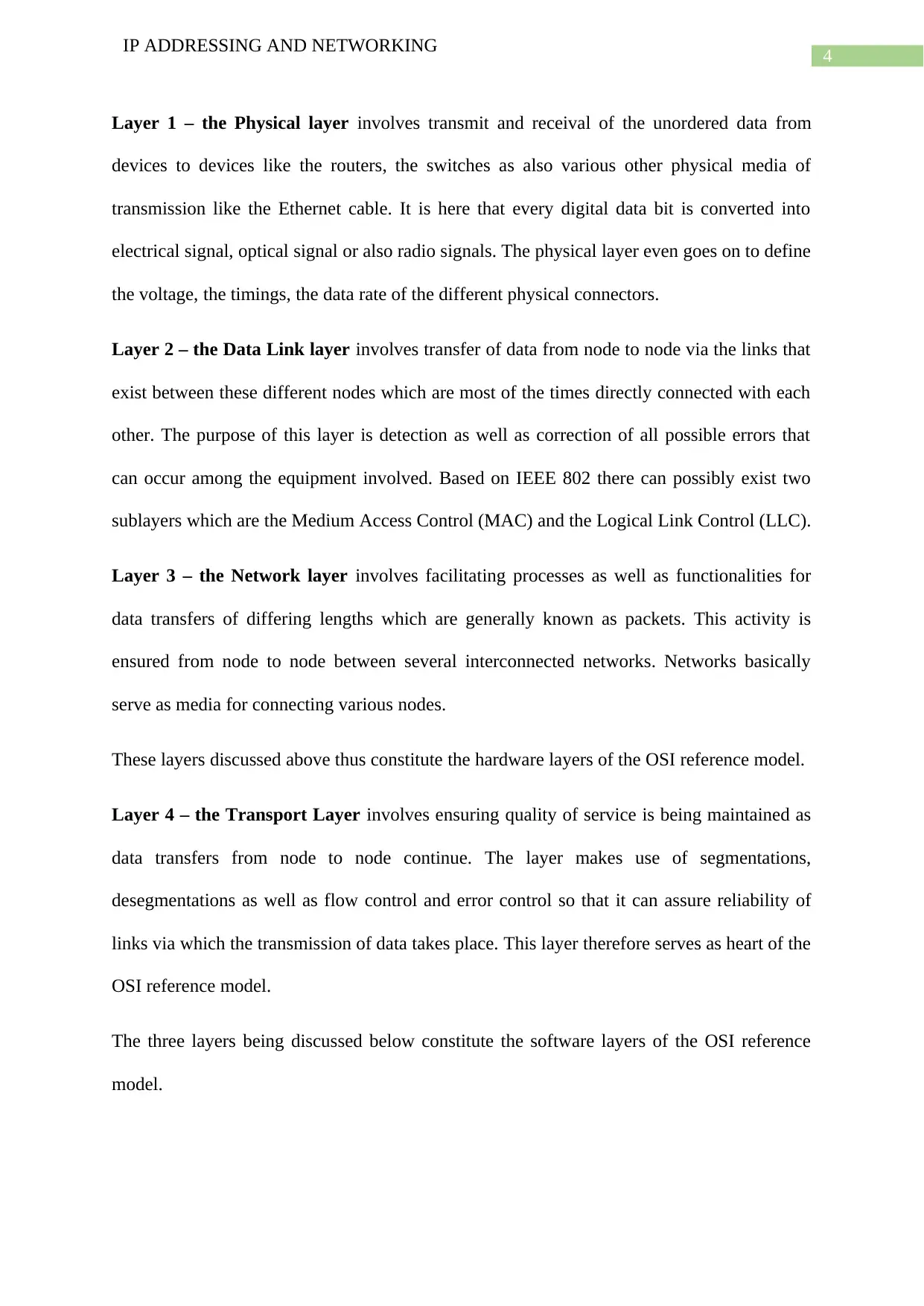
4
IP ADDRESSING AND NETWORKING
Layer 1 – the Physical layer involves transmit and receival of the unordered data from
devices to devices like the routers, the switches as also various other physical media of
transmission like the Ethernet cable. It is here that every digital data bit is converted into
electrical signal, optical signal or also radio signals. The physical layer even goes on to define
the voltage, the timings, the data rate of the different physical connectors.
Layer 2 – the Data Link layer involves transfer of data from node to node via the links that
exist between these different nodes which are most of the times directly connected with each
other. The purpose of this layer is detection as well as correction of all possible errors that
can occur among the equipment involved. Based on IEEE 802 there can possibly exist two
sublayers which are the Medium Access Control (MAC) and the Logical Link Control (LLC).
Layer 3 – the Network layer involves facilitating processes as well as functionalities for
data transfers of differing lengths which are generally known as packets. This activity is
ensured from node to node between several interconnected networks. Networks basically
serve as media for connecting various nodes.
These layers discussed above thus constitute the hardware layers of the OSI reference model.
Layer 4 – the Transport Layer involves ensuring quality of service is being maintained as
data transfers from node to node continue. The layer makes use of segmentations,
desegmentations as well as flow control and error control so that it can assure reliability of
links via which the transmission of data takes place. This layer therefore serves as heart of the
OSI reference model.
The three layers being discussed below constitute the software layers of the OSI reference
model.
IP ADDRESSING AND NETWORKING
Layer 1 – the Physical layer involves transmit and receival of the unordered data from
devices to devices like the routers, the switches as also various other physical media of
transmission like the Ethernet cable. It is here that every digital data bit is converted into
electrical signal, optical signal or also radio signals. The physical layer even goes on to define
the voltage, the timings, the data rate of the different physical connectors.
Layer 2 – the Data Link layer involves transfer of data from node to node via the links that
exist between these different nodes which are most of the times directly connected with each
other. The purpose of this layer is detection as well as correction of all possible errors that
can occur among the equipment involved. Based on IEEE 802 there can possibly exist two
sublayers which are the Medium Access Control (MAC) and the Logical Link Control (LLC).
Layer 3 – the Network layer involves facilitating processes as well as functionalities for
data transfers of differing lengths which are generally known as packets. This activity is
ensured from node to node between several interconnected networks. Networks basically
serve as media for connecting various nodes.
These layers discussed above thus constitute the hardware layers of the OSI reference model.
Layer 4 – the Transport Layer involves ensuring quality of service is being maintained as
data transfers from node to node continue. The layer makes use of segmentations,
desegmentations as well as flow control and error control so that it can assure reliability of
links via which the transmission of data takes place. This layer therefore serves as heart of the
OSI reference model.
The three layers being discussed below constitute the software layers of the OSI reference
model.
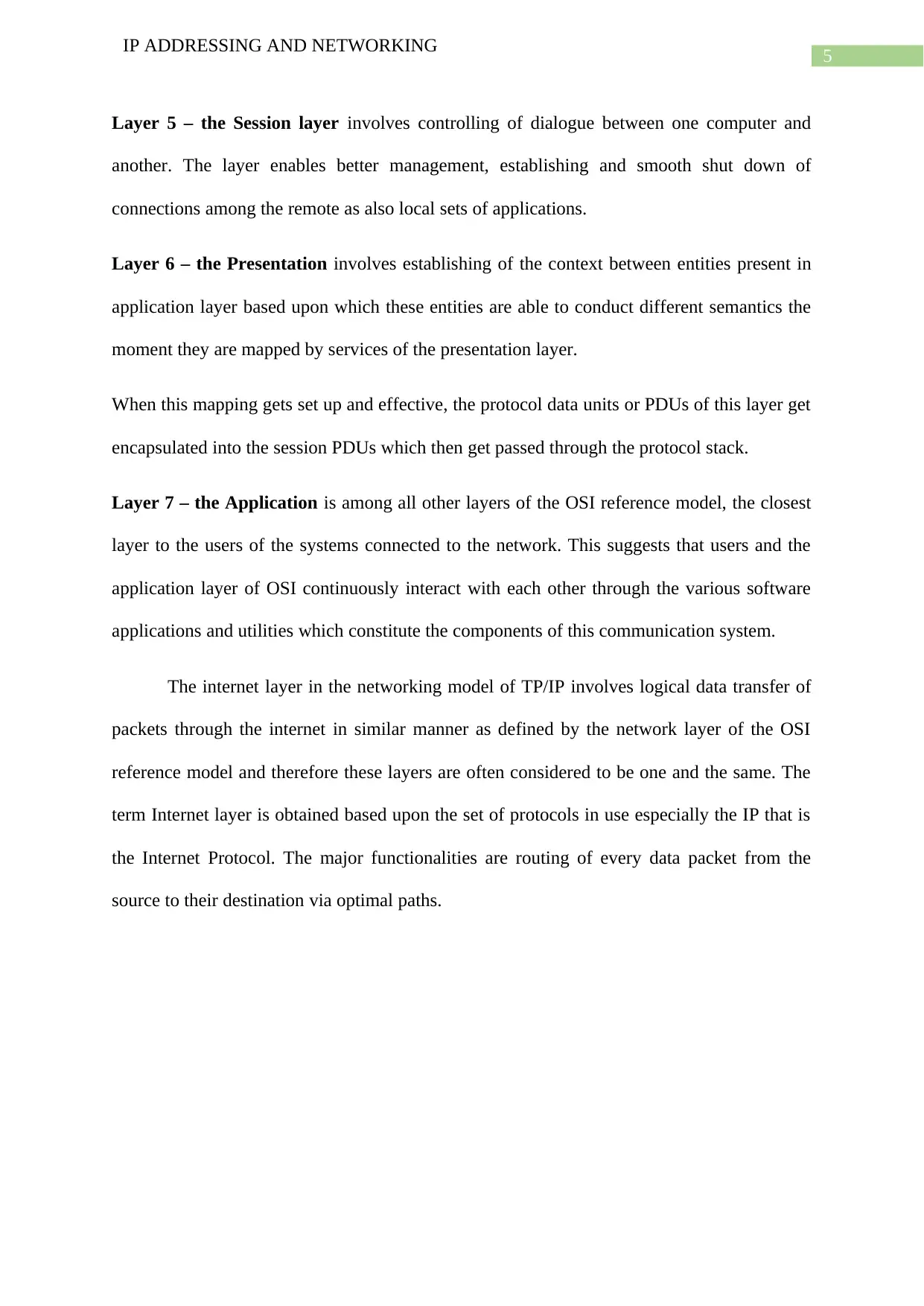
5
IP ADDRESSING AND NETWORKING
Layer 5 – the Session layer involves controlling of dialogue between one computer and
another. The layer enables better management, establishing and smooth shut down of
connections among the remote as also local sets of applications.
Layer 6 – the Presentation involves establishing of the context between entities present in
application layer based upon which these entities are able to conduct different semantics the
moment they are mapped by services of the presentation layer.
When this mapping gets set up and effective, the protocol data units or PDUs of this layer get
encapsulated into the session PDUs which then get passed through the protocol stack.
Layer 7 – the Application is among all other layers of the OSI reference model, the closest
layer to the users of the systems connected to the network. This suggests that users and the
application layer of OSI continuously interact with each other through the various software
applications and utilities which constitute the components of this communication system.
The internet layer in the networking model of TP/IP involves logical data transfer of
packets through the internet in similar manner as defined by the network layer of the OSI
reference model and therefore these layers are often considered to be one and the same. The
term Internet layer is obtained based upon the set of protocols in use especially the IP that is
the Internet Protocol. The major functionalities are routing of every data packet from the
source to their destination via optimal paths.
IP ADDRESSING AND NETWORKING
Layer 5 – the Session layer involves controlling of dialogue between one computer and
another. The layer enables better management, establishing and smooth shut down of
connections among the remote as also local sets of applications.
Layer 6 – the Presentation involves establishing of the context between entities present in
application layer based upon which these entities are able to conduct different semantics the
moment they are mapped by services of the presentation layer.
When this mapping gets set up and effective, the protocol data units or PDUs of this layer get
encapsulated into the session PDUs which then get passed through the protocol stack.
Layer 7 – the Application is among all other layers of the OSI reference model, the closest
layer to the users of the systems connected to the network. This suggests that users and the
application layer of OSI continuously interact with each other through the various software
applications and utilities which constitute the components of this communication system.
The internet layer in the networking model of TP/IP involves logical data transfer of
packets through the internet in similar manner as defined by the network layer of the OSI
reference model and therefore these layers are often considered to be one and the same. The
term Internet layer is obtained based upon the set of protocols in use especially the IP that is
the Internet Protocol. The major functionalities are routing of every data packet from the
source to their destination via optimal paths.
⊘ This is a preview!⊘
Do you want full access?
Subscribe today to unlock all pages.

Trusted by 1+ million students worldwide
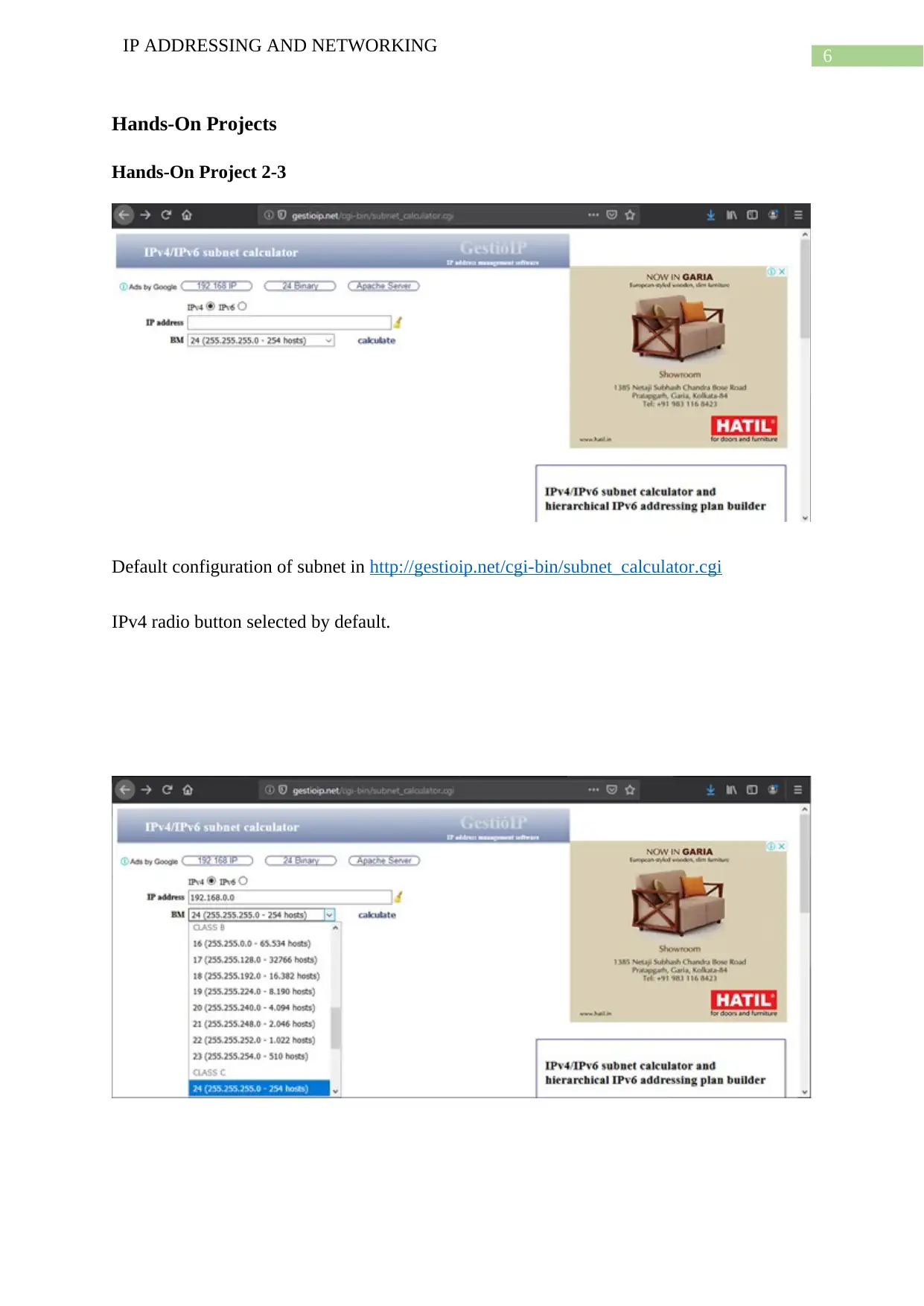
6
IP ADDRESSING AND NETWORKING
Hands-On Projects
Hands-On Project 2-3
Default configuration of subnet in http://gestioip.net/cgi-bin/subnet_calculator.cgi
IPv4 radio button selected by default.
IP ADDRESSING AND NETWORKING
Hands-On Projects
Hands-On Project 2-3
Default configuration of subnet in http://gestioip.net/cgi-bin/subnet_calculator.cgi
IPv4 radio button selected by default.
Paraphrase This Document
Need a fresh take? Get an instant paraphrase of this document with our AI Paraphraser
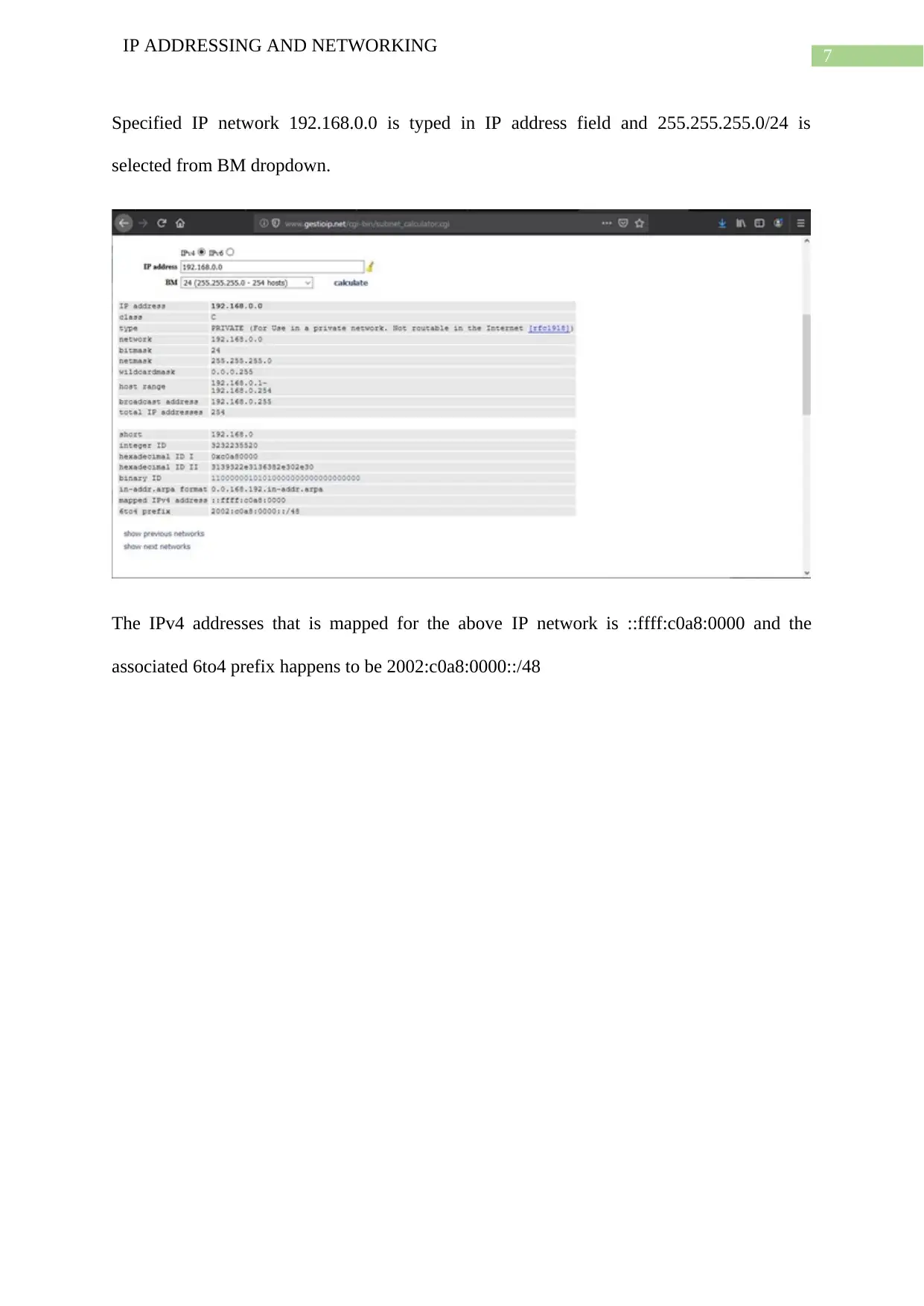
7
IP ADDRESSING AND NETWORKING
Specified IP network 192.168.0.0 is typed in IP address field and 255.255.255.0/24 is
selected from BM dropdown.
The IPv4 addresses that is mapped for the above IP network is ::ffff:c0a8:0000 and the
associated 6to4 prefix happens to be 2002:c0a8:0000::/48
IP ADDRESSING AND NETWORKING
Specified IP network 192.168.0.0 is typed in IP address field and 255.255.255.0/24 is
selected from BM dropdown.
The IPv4 addresses that is mapped for the above IP network is ::ffff:c0a8:0000 and the
associated 6to4 prefix happens to be 2002:c0a8:0000::/48
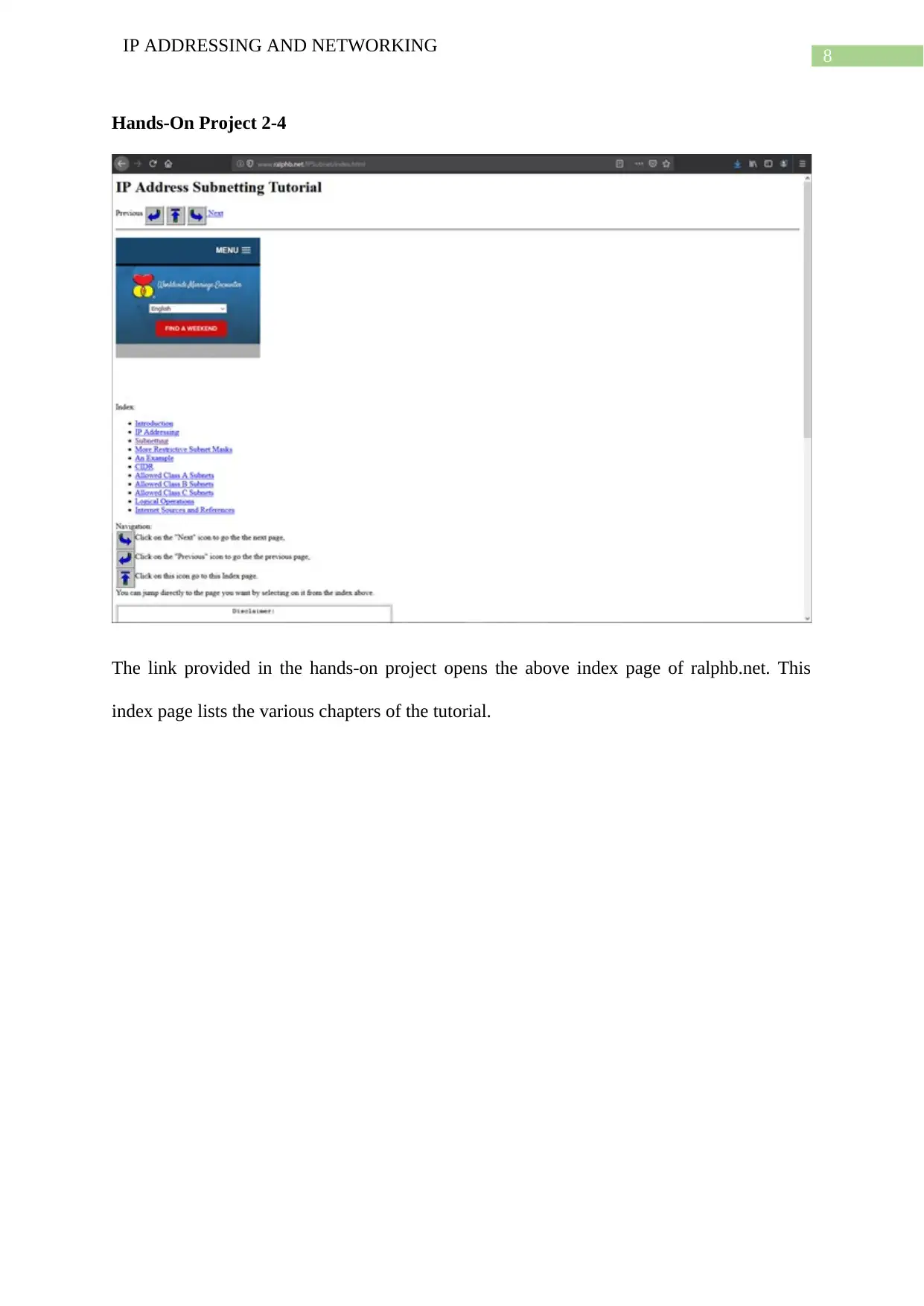
8
IP ADDRESSING AND NETWORKING
Hands-On Project 2-4
The link provided in the hands-on project opens the above index page of ralphb.net. This
index page lists the various chapters of the tutorial.
IP ADDRESSING AND NETWORKING
Hands-On Project 2-4
The link provided in the hands-on project opens the above index page of ralphb.net. This
index page lists the various chapters of the tutorial.
⊘ This is a preview!⊘
Do you want full access?
Subscribe today to unlock all pages.

Trusted by 1+ million students worldwide
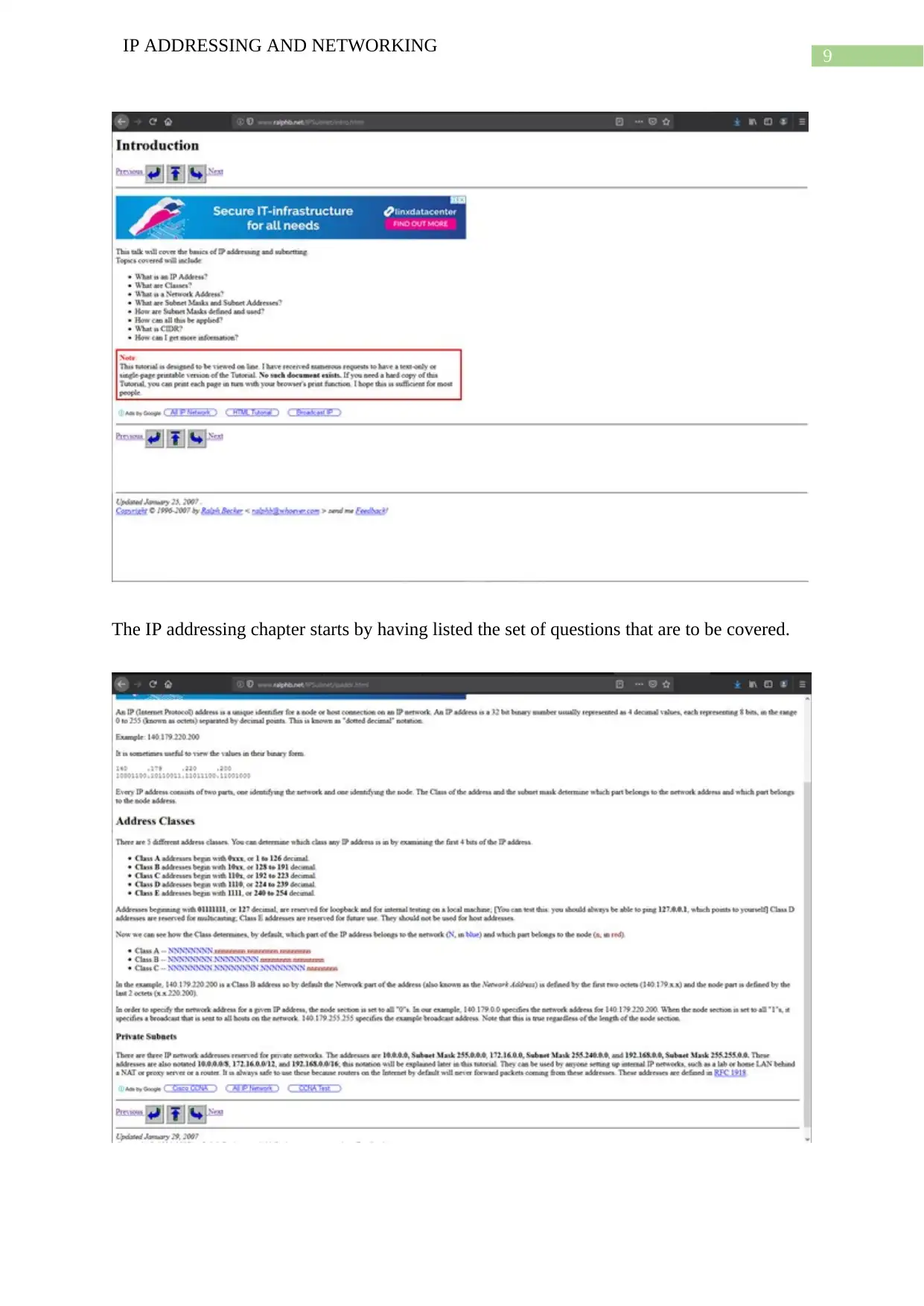
9
IP ADDRESSING AND NETWORKING
The IP addressing chapter starts by having listed the set of questions that are to be covered.
IP ADDRESSING AND NETWORKING
The IP addressing chapter starts by having listed the set of questions that are to be covered.
Paraphrase This Document
Need a fresh take? Get an instant paraphrase of this document with our AI Paraphraser
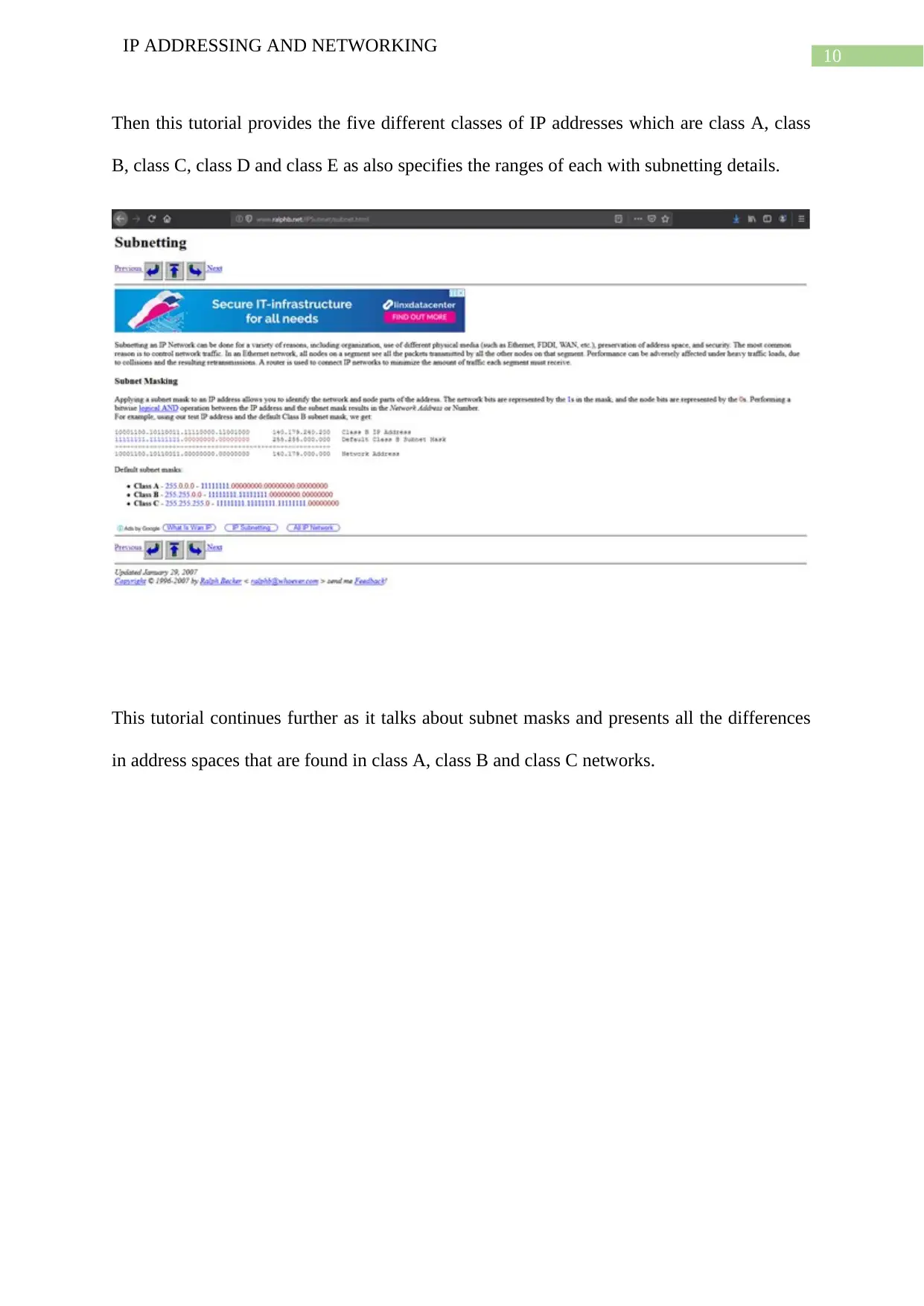
10
IP ADDRESSING AND NETWORKING
Then this tutorial provides the five different classes of IP addresses which are class A, class
B, class C, class D and class E as also specifies the ranges of each with subnetting details.
This tutorial continues further as it talks about subnet masks and presents all the differences
in address spaces that are found in class A, class B and class C networks.
IP ADDRESSING AND NETWORKING
Then this tutorial provides the five different classes of IP addresses which are class A, class
B, class C, class D and class E as also specifies the ranges of each with subnetting details.
This tutorial continues further as it talks about subnet masks and presents all the differences
in address spaces that are found in class A, class B and class C networks.
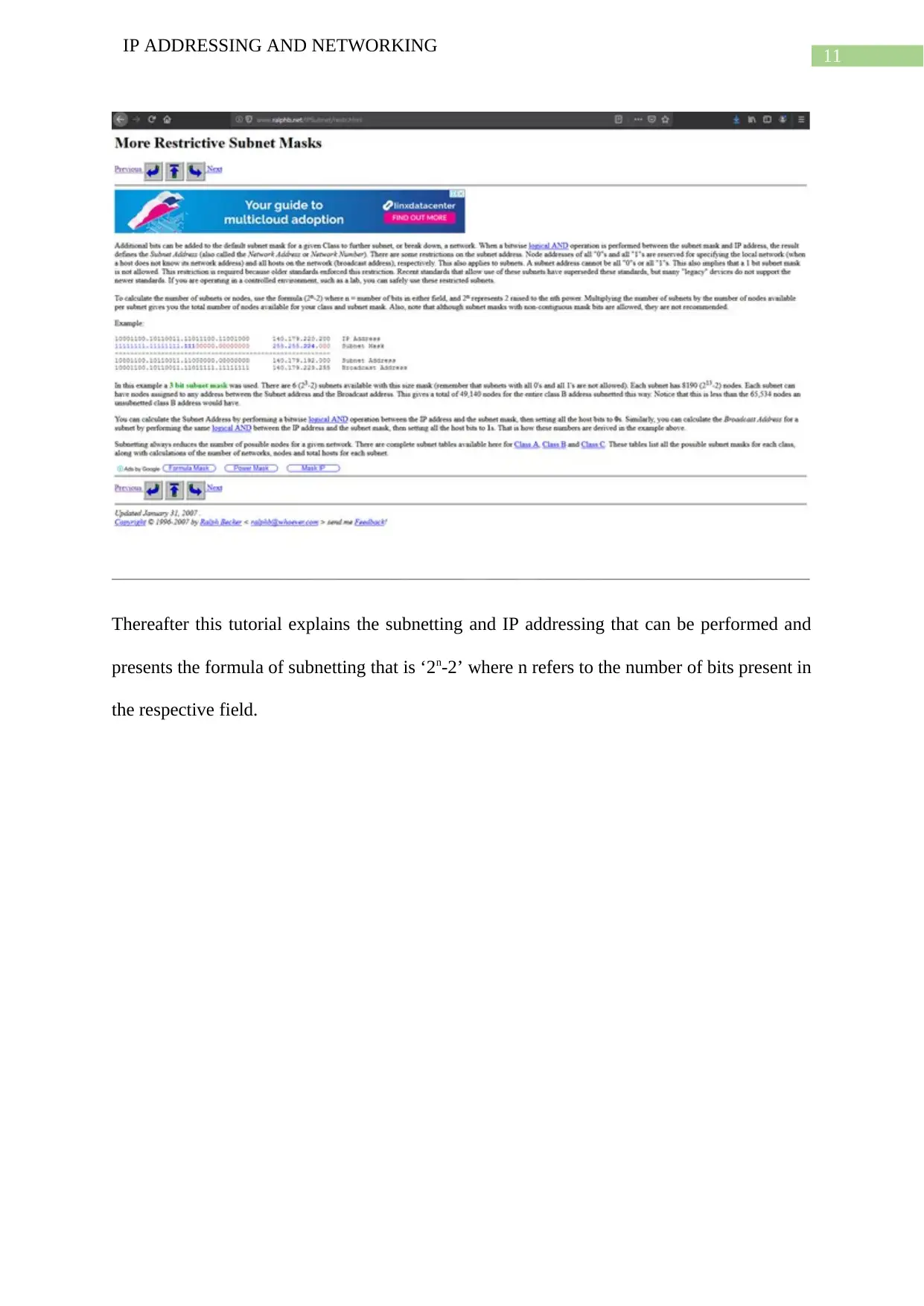
11
IP ADDRESSING AND NETWORKING
Thereafter this tutorial explains the subnetting and IP addressing that can be performed and
presents the formula of subnetting that is ‘2n-2’ where n refers to the number of bits present in
the respective field.
IP ADDRESSING AND NETWORKING
Thereafter this tutorial explains the subnetting and IP addressing that can be performed and
presents the formula of subnetting that is ‘2n-2’ where n refers to the number of bits present in
the respective field.
⊘ This is a preview!⊘
Do you want full access?
Subscribe today to unlock all pages.

Trusted by 1+ million students worldwide
1 out of 30
Related Documents
Your All-in-One AI-Powered Toolkit for Academic Success.
+13062052269
info@desklib.com
Available 24*7 on WhatsApp / Email
![[object Object]](/_next/static/media/star-bottom.7253800d.svg)
Unlock your academic potential
Copyright © 2020–2025 A2Z Services. All Rights Reserved. Developed and managed by ZUCOL.



